Application of Proper Orthogonal Decomposition to Elucidate Spatial and Temporal Correlations in Air Pollution Across the City of Liverpool, UK
Abstract
1. Introduction
2. Methods
2.1. Study Area and Descriptive Analysis
2.2. Proper Orthogonal Decomposition
3. Results and Discussion
3.1. Data Analysis—Descriptive Statistics
3.2. Data Analysis—Spatial Interpolation
3.3. Proper Orthogonal Decomposition
- The dominant shows correlated increases in the whole of the study area. PM2.5 pollution changes more in the south of the LCR, while PM10 increases both in the southern and northern regions, albeit to a lesser extent. The dominant periodicity of is daily, suggesting cyclic components such as TEM and RH linked to the pollution level changes in . However, considering that the spatial correlation between the meteorology variables and pollution levels in Figure 4 is not clear-cut, anthropogenic factors could also be driving PM changes. This is supported by the daily patterns of the time coefficients, in which the positive contributions of the PM mode are observed in the morning and evening. Overall, the increases in pollution levels can be linked to both temperature and changes in traffic, potentially due to transport from residential areas to workplaces.
- shows positive correlations with simultaneous reductions in PM. The patterns of PM2.5 and PM10 changes in share similarities between both pollutants suggesting a common source driving their changes. Areas with higher TEM positive changes experience more significant negative changes in PM magnitudes, supporting the inverse relationship observed in Figure 3. The most dominant frequencies showed weekly to 1-month periodicity, corresponding to shifts in activities on a weekly and fortnightly basis.
- PM2.5 decreases at varying rates across the LCR in , with higher reductions in the north compared to the south. PM10 tends to increase significantly from the center to the southern regions, with lower increases observed in the northeast. These simultaneous variations could reflect the movement of pollution throughout the LCR. dominant frequency is 57 days, and it may be associated with seasonal short-term changes (top 10 dominant frequencies ~1 month), as well as cyclic components such as temperature, considering its daily pattern.
- In , PM2.5 increases across the study area with higher increases in the changes across residential and urban areas transitioning into commercial/industrial features. In contrast, PM10 magnitudes decrease in the south of the LCR. While the contribution is limited, this mode may indicate isolated events or temporal changes resulting in correlated pollutant changes in specific regions. Temporal coefficients () vary significantly throughout 2023, with a dominant frequency of 21 days. Its daily pattern is similar to and , suggesting that these modes might share common sources or behavior.
3.4. Implications for Urban Air Pollution Management
4. Conclusions
Author Contributions
Funding
Data Availability Statement
Conflicts of Interest
Appendix A. POD Pseudocode
| Algorithm A1: Proper orthogonal decomposition (POD) |
 |
| Algorithm A2: Function: mean_along_time |
 |
| Algorithm A3: Function: reshape_data |
 |
| Algorithm A4: Function: svd |
 |
| Algorithm A5: Function: create_diagonal_matrix |
 |
Appendix B. Modes Details
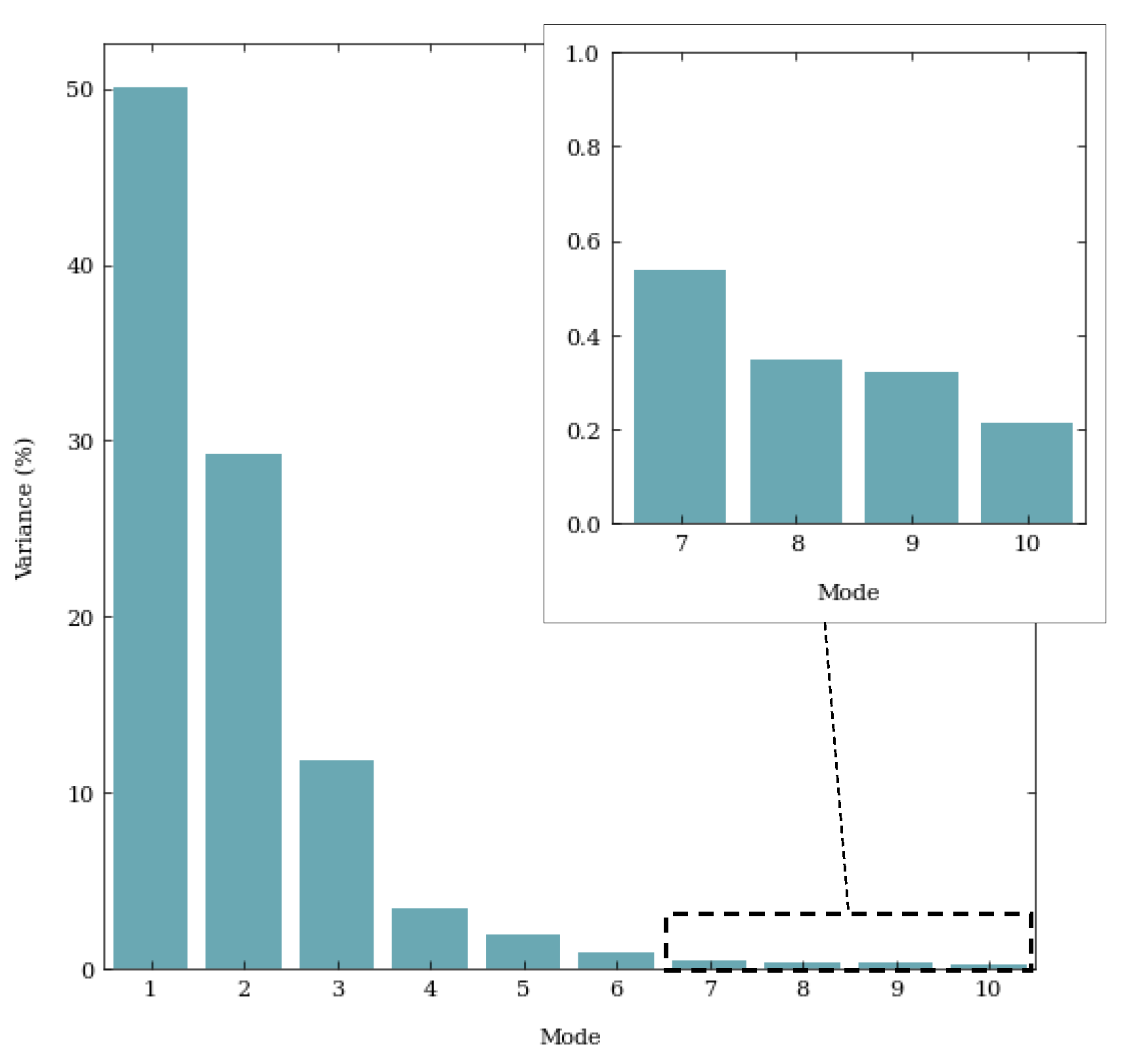

References
- WHO. Ambient (Outdoor) Air Pollution; WHO: Geneva, Switzerland, 2023. [Google Scholar]
- Bălă, G.P.; Râjnoveanu, R.M.; Tudorache, E.; Motișan, R.; Oancea, C. Air pollution exposure—The (in)visible risk factor for respiratory diseases. Environ. Sci. Pollut. Res. 2021, 28, 19615–19628. [Google Scholar] [CrossRef]
- Chen, R.; Jiang, Y.; Hu, J.; Chen, H.; Li, H.; Meng, X.; Ji, J.S.; Gao, Y.; Wang, W.; Liu, C.; et al. Hourly Air Pollutants and Acute Coronary Syndrome Onset in 1.29 Million Patients. Circulation 2022, 145, 1749–1760. [Google Scholar] [CrossRef]
- Delgado-Saborit, J.M.; Guercio, V.; Gowers, A.M.; Shaddick, G.; Fox, N.C.; Love, S. A critical review of the epidemiological evidence of effects of air pollution on dementia, cognitive function and cognitive decline in adult population. Sci. Total Environ. 2021, 757, 143734. [Google Scholar] [CrossRef]
- Wolf, K.; Hoffmann, B.; Andersen, Z.J.; Atkinson, R.W.; Bauwelinck, M.; Bellander, T.; Brandt, J.; Brunekreef, B.; Cesaroni, G.; Chen, J.; et al. Long-term exposure to low-level ambient air pollution and incidence of stroke and coronary heart disease: A pooled analysis of six European cohorts within the ELAPSE project. Lancet Planet. Health 2021, 5, e620–e632. [Google Scholar] [CrossRef]
- Zhu, F.; Ding, R.; Lei, R.; Cheng, H.; Liu, J.; Shen, C.; Zhang, C.; Xu, Y.; Xiao, C.; Li, X.; et al. The short-term effects of air pollution on respiratory diseases and lung cancer mortality in Hefei: A time-series analysis. Respir. Med. 2019, 146, 57–65. [Google Scholar] [CrossRef]
- Defra. Air Quality Statistics; Defra: London, UK, 2023.
- Alemayehu, Y.A.; Asfaw, S.L.; Terfie, T.A. Exposure to urban particulate matter and its association with human health risks. Environ. Sci. Pollut. Res. 2020, 27, 27491–27506. [Google Scholar] [CrossRef]
- Arias-Pérez, R.D.; Taborda, N.A.; Gómez, D.M.; Narvaez, J.F.; Porras, J.; Hernandez, J.C. Inflammatory effects of particulate matter air pollution. Environ. Sci. Pollut. Res. 2020, 27, 42390–42404. [Google Scholar] [CrossRef]
- Liu, C.; Chan, K.H.; Lv, J.; Lam, H.; Newell, K.; Meng, X.; Liu, Y.; Chen, R.; Kartsonaki, C.; Wright, N.; et al. Long-Term Exposure to Ambient Fine Particulate Matter and Incidence of Major Cardiovascular Diseases: A Prospective Study of 0.5 Million Adults in China. Environ. Sci. Technol. 2022, 56, 13200–13211. [Google Scholar] [CrossRef]
- Psistaki, K.; Achilleos, S.; Middleton, N.; Paschalidou, A.K. Exploring the impact of particulate matter on mortality in coastal Mediterranean environments. Sci. Total Environ. 2023, 865, 161147. [Google Scholar] [CrossRef]
- Guo, Q.; Zhang, K.; Wang, B.; Cao, S.; Xue, T.; Zhang, Q.; Tian, H.; Fu, P.; Zhang, J.J.; Duan, X. Chemical constituents of ambient fine particulate matter and obesity among school-aged children. Sci. Total Environ. 2022, 849, 157742. [Google Scholar] [CrossRef]
- Lin, L.Z.; Zhan, X.L.; Jin, C.Y.; Liang, J.H.; Jing, J.; Dong, G.H. The epidemiological evidence linking exposure to ambient particulate matter with neurodevelopmental disorders: A systematic review and meta-analysis. Environ. Res. 2022, 209, 112876. [Google Scholar] [CrossRef]
- Park, S.J.; Lee, J.; Lee, S.; Lim, S.; Noh, J.; Cho, S.Y.; Ha, J.; Kim, H.; Kim, C.; Park, S.; et al. Exposure of ultrafine particulate matter causes glutathione redox imbalance in the hippocampus: A neurometabolic susceptibility to Alzheimer’s pathology. Sci. Total Environ. 2020, 718, 137267. [Google Scholar] [CrossRef]
- IQAir. 2024 World Air Quality Report; IQAir Reports; IQAir: Goldach, Switzerland, 2024. [Google Scholar]
- Health Effects Institute; UNICEF. State of Global Air 2024: A Comprehensive Analysis of Air Quality and Health Impacts Worldwide; Special Report; UNICEF: New York, NY, USA, 2024. [Google Scholar]
- Boogaard, H.; Pant, P.; Künzli, N. Science to Foster the WHO Air Quality Guideline Values. Int. J. Public Health 2025, 69, 1608249. [Google Scholar] [CrossRef]
- Hu, K.; Sivaraman, V.; Luxan, B.G.; Rahman, A. Design and Evaluation of a Metropolitan Air Pollution Sensing System. IEEE Sens. J. 2016, 16, 1448–1459. [Google Scholar] [CrossRef]
- Patel, H.; Talbot, N.; Dirks, K.; Salmond, J. The impact of low emission zones on personal exposure to ultrafine particles in the commuter environment. Sci. Total Environ. 2023, 874, 162540. [Google Scholar] [CrossRef]
- Liang, L.; Daniels, J.; Bailey, C.; Hu, L.; Phillips, R.; South, J. Integrating low-cost sensor monitoring, satellite mapping, and geospatial artificial intelligence for intra-urban air pollution predictions. Environ. Pollut. 2023, 331, 121832. [Google Scholar] [CrossRef]
- Gameli Hodoli, C.; Coulon, F.; Mead, M.I. Applicability of factory calibrated optical particle counters for high-density air quality monitoring networks in Ghana. Heliyon 2020, 6, e04206. [Google Scholar] [CrossRef]
- Magi, B.I.; Cupini, C.; Francis, J.; Green, M.; Hauser, C. Evaluation of PM2.5 measured in an urban setting using a low-cost optical particle counter and a Federal Equivalent Method Beta Attenuation Monitor. Aerosol Sci. Technol. 2020, 54, 147–159. [Google Scholar] [CrossRef]
- Hassani, A.; Castell, N.; Watne, A.K.; Schneider, P. Citizen-operated mobile low-cost sensors for urban PM2.5 monitoring: Field calibration, uncertainty estimation, and application. Sustain. Cities Soc. 2023, 95, 104607. [Google Scholar] [CrossRef]
- Lertsinsrubtavee, A.; Kanabkaew, T.; Raksakietisak, S. Detection of forest fires and pollutant plume dispersion using IoT air quality sensors. Environ. Pollut. 2023, 338, 122701. [Google Scholar] [CrossRef]
- Kingsy Grace, R.; Manju, S. A Comprehensive Review of Wireless Sensor Networks Based Air Pollution Monitoring Systems. Wirel. Pers. Commun. 2019, 108, 2499–2515. [Google Scholar] [CrossRef]
- Wei, P.; Brimblecombe, P.; Yang, F.; Anand, A.; Xing, Y.; Sun, L.; Sun, Y.; Chu, M.; Ning, Z. Determination of local traffic emission and non-local background source contribution to on-road air pollution using fixed-route mobile air sensor network. Environ. Pollut. 2021, 290, 118055. [Google Scholar] [CrossRef]
- Adrian, R.J. Twenty years of particle image velocimetry. Exp. Fluids 2005, 39, 159–169. [Google Scholar] [CrossRef]
- Lumley, J.L. The Structure of Inhomogeneous Turbulent Flows. In Atmospheric Turbulence and Radio Wave Propagation; Nauka: Moscow, USSR, 1967; pp. 166–177. [Google Scholar]
- Holmes, P.; Lumley, J.L.; Berkooz, G. Proper orthogonal decomposition. In Turbulence, Coherent Structures, Dynamical Systems and Symmetry; Berkooz, G., Lumley, J.L., Holmes, P., Eds.; Cambridge Monographs on Mechanics, Cambridge University Press: Cambridge, UK, 1996; pp. 86–128. [Google Scholar] [CrossRef]
- Higham, J.; Brevis, W.; Keylock, C.; Safarzadeh, A. Using modal decompositions to explain the sudden expansion of the mixing layer in the wake of a groyne in a shallow flow. Adv. Water Resour. 2017, 107, 451–459. [Google Scholar] [CrossRef]
- Higham, J.E.; Brevis, W.; Keylock, C.J. Implications of the selection of a particular modal decomposition technique for the analysis of shallow flows. J. Hydraul. Res. 2018, 56, 796–805. [Google Scholar] [CrossRef]
- Higham, J.E.; Shahnam, M.; Vaidheeswaran, A. Using a proper orthogonal decomposition to elucidate features in granular flows. Granul. Matter 2020, 22, 86. [Google Scholar] [CrossRef]
- Higham, J.; Vaidheeswaran, A. Modification of modal characteristics in the wakes of blockages of square cylinders with multi-scale porosity. Phys. Fluids 2022, 34, 025114. [Google Scholar] [CrossRef]
- Ashmore, D.W.; Mair, D.W.F.; Higham, J.E.; Brough, S.; Lea, J.M.; Nias, I.J. Proper orthogonal decomposition of ice velocity identifies drivers of flow variability at Sermeq Kujalleq (Jakobshavn Isbræ). Cryosphere 2022, 16, 219–236. [Google Scholar] [CrossRef]
- Zhang, B.; Ooka, R.; Kikumoto, H. Spectral Proper Orthogonal Decomposition Analysis of Turbulent Flow in a Two-Dimensional Street Canyon and Its Role in Pollutant Removal. Bound.-Layer Meteorol. 2022, 183, 97–123. [Google Scholar] [CrossRef]
- Ashrafi, K. Determining of spatial distribution patterns and temporal trends of an air pollutant using proper orthogonal decomposition basis functions. Atmos. Environ. 2012, 47, 468–476. [Google Scholar] [CrossRef]
- Liu, Y.; Liu, C.H.; Brasseur, G.P.; Chao, C.Y.H. Proper orthogonal decomposition of large-eddy simulation data over real urban morphology. Sustain. Cities Soc. 2023, 89, 104324. [Google Scholar] [CrossRef]
- Jafarzadeh, S.; Jess, D.B.; Stangalini, M.; Grant, S.D.; Higham, J.E.; Pessah, M.E.; Keys, P.H.; Belov, S.; Calchetti, D.; Duckenfield, T.J.; et al. Wave analysis tools. Nat. Rev. Methods Prim. 2025, 5, 21. [Google Scholar] [CrossRef]
- Albidah, A.; Fedun, V.; Aldhafeeri, A.; Ballai, I.; Jess, D.; Brevis, W.; Higham, J.; Stangalini, M.; Silva, S.; MacBride, C.; et al. The temporal and spatial evolution of magnetohydrodynamic wave modes in sunspots. Astrophys. J. 2023, 954, 30. [Google Scholar] [CrossRef]
- ONS. How the Population Changed in Liverpool, Census 2021; ONS: London, UK, 2021.
- Kottek, M.; Grieser, J.; Beck, C.; Rudolf, B.; Rubel, F. World Map of the Koppen-Geiger climate classification updated. Meteorol. Z. 2006, 15, 259–263. [Google Scholar] [CrossRef]
- ICL. Liverpool City Region Combined Authority Health And Economic Impact Assessment Study; ICL: Tokyo, Japan, 2020. [Google Scholar]
- Authority, L.C. Improving Our Air Quality 2020. Available online: https://www.liverpoolcityregion-ca.gov.uk/improving-our-air-quality (accessed on 14 April 2025).
- Mekki, K.; Bajic, E.; Chaxel, F.; Meyer, F. A comparative study of LPWAN technologies for large-scale IoT deployment. ICT Express 2019, 5, 1–7. [Google Scholar] [CrossRef]
- Muller, C.L.; Chapman, L.; Grimmond, C.S.B.; Young, D.T.; Cai, X. Sensors and the city: A review of urban meteorological networks: SENSORS AND THE CITY. Int. J. Climatol. 2013, 33, 1585–1600. [Google Scholar] [CrossRef]
- Cole, B.; De la Barreda, B.; Hamer, A.; Codd, T.; Payne, M.; Chan, L.; Smith, G.; Balzter, H. Corine Land Cover 2018 for the UK, Isle of Man, Jersey and Guernsey; Environmental Information Data Centre: Lancaster, UK, 2021. [Google Scholar]
- Higham, J.E.; Brevis, W. When, what and how image transformation techniques should be used to reduce error in Particle Image Velocimetry data? Flow Meas. Instrum. 2019, 66, 79–85. [Google Scholar] [CrossRef]
- Hussain, A.K.M.F. Coherent structures—Reality and myth. Phys. Fluids 1983, 26, 2816–2850. [Google Scholar] [CrossRef]
- Aubry, N. On the hidden beauty of the proper orthogonal decomposition. Theor. Comput. Fluid Dyn. 1991, 2, 339–352. [Google Scholar] [CrossRef]
- Sirovich, L.; Rodriguez, J.D. Coherent structures and chaos: A model problem. Phys. Lett. A 1987, 120, 211–214. [Google Scholar] [CrossRef]
- Schmid, P.J. Dynamic mode decomposition of numerical and experimental data. J. Fluid Mech. 2010, 656, 5–28. [Google Scholar] [CrossRef]
- Defra. Particulate matter (PM10/PM2.5); Defra: London, UK, 2023.
- Luo, J.; Du, P.; Samat, A.; Xia, J.; Che, M.; Xue, Z. Spatiotemporal Pattern of PM2.5 Concentrations in Mainland China and Analysis of Its Influencing Factors using Geographically Weighted Regression. Sci. Rep. 2017, 7, 40607. [Google Scholar] [CrossRef]
- WHO. WHO Global Air Quality Guidelines: Particulate Matter (PM2.5 and PM10), Ozone, Nitrogen Dioxide, Sulfur Dioxide and Carbon Monoxide; WHO: Geneva, Switzerland, 2021. [Google Scholar]
- WMO. WMO Air Quality and Climate Bulletin No. 4—September 2024. In World Meteorological Organization Bulletin; Released for Clean Air for Blue Skies Day; WMO: Geneva, Switzerland, 2024. [Google Scholar]
- Higham, J.E.; Ram’ırez, C.A.; Green, M.A.; Morse, A.P. UK COVID-19 lockdown: 100 days of air pollution reduction? Air Qual. Atmos. Health 2021, 14, 325–332. [Google Scholar] [CrossRef]
- Hathway, E.A.; Sharples, S. The interaction of rivers and urban form in mitigating the Urban Heat Island effect: A UK case study. Build. Environ. 2012, 58, 14–22. [Google Scholar] [CrossRef]
- Peralta Abadía, J.J.; Walther, C.; Osman, A.; Smarsly, K. A systematic survey of Internet of Things frameworks for smart city applications. Sustain. Cities Soc. 2022, 83, 103949. [Google Scholar] [CrossRef]
- Zhang, S.; Niu, T.; Wu, Y.; Zhang, K.M.; Wallington, T.J.; Xie, Q.; Wu, X.; Xu, H. Fine-grained vehicle emission management using intelligent transportation system data. Environ. Pollut. 2018, 241, 1027–1037. [Google Scholar] [CrossRef]
- McKercher, G.R.; Salmond, J.A.; Vanos, J.K. Characteristics and applications of small, portable gaseous air pollution monitors. Environ. Pollut. 2017, 223, 102–110. [Google Scholar] [CrossRef]
- Cao, R.; Li, B.; Wang, Z.; Peng, Z.R.; Tao, S.; Lou, S. Using a distributed air sensor network to investigate the spatiotemporal patterns of PM2.5 concentrations. Environ. Pollut. 2020, 264, 114549. [Google Scholar] [CrossRef]
- Gameli Hodoli, C.; Coulon, F.; Mead, M.I. Source identification with high-temporal resolution data from low-cost sensors using bivariate polar plots in urban areas of Ghana. Environ. Pollut. 2023, 317, 120448. [Google Scholar] [CrossRef]
- Considine, E.M.; Reid, C.E.; Ogletree, M.R.; Dye, T. Improving accuracy of air pollution exposure measurements: Statistical correction of a municipal low-cost airborne particulate matter sensor network. Environ. Pollut. 2021, 268, 115833. [Google Scholar] [CrossRef]
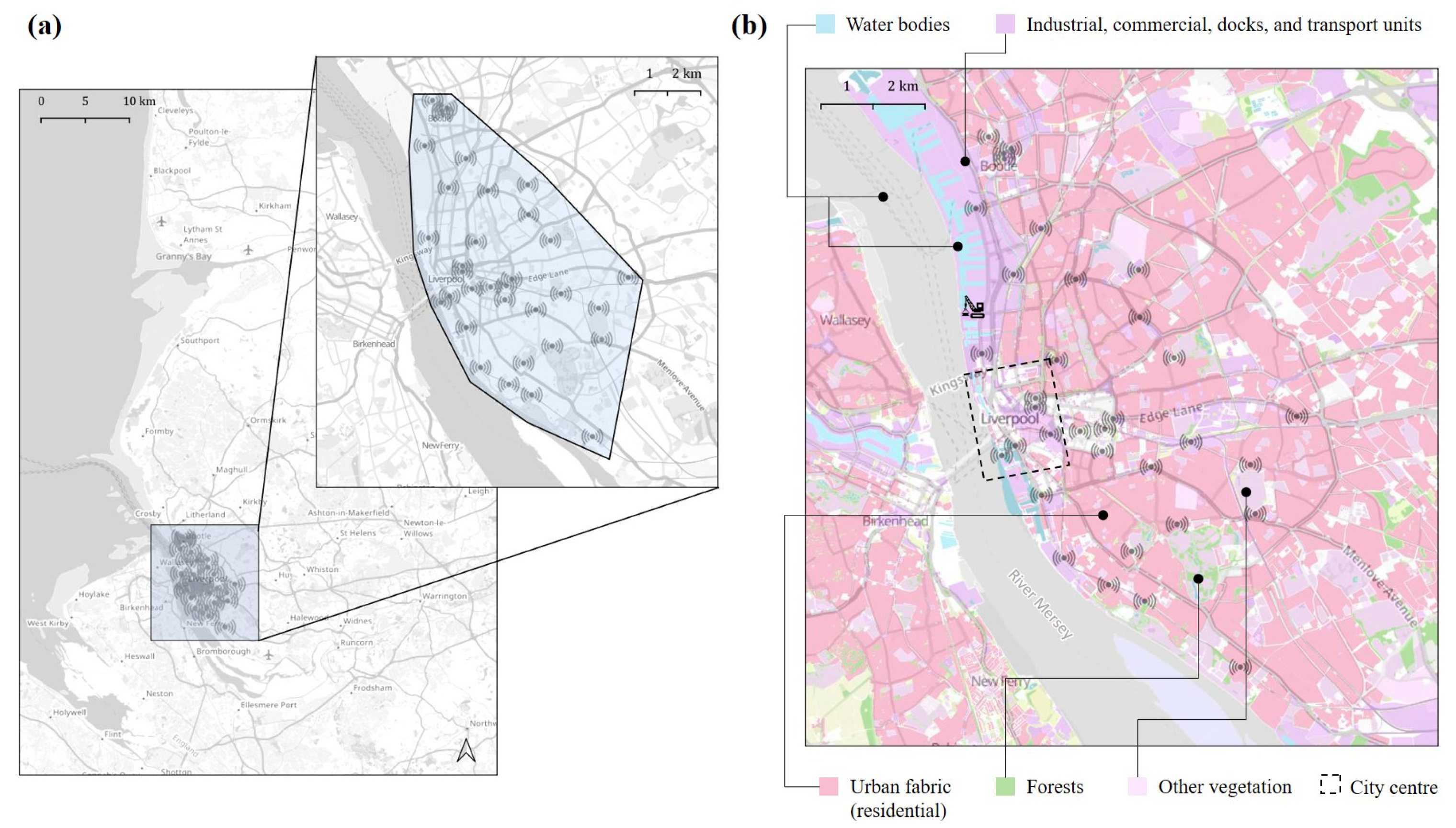

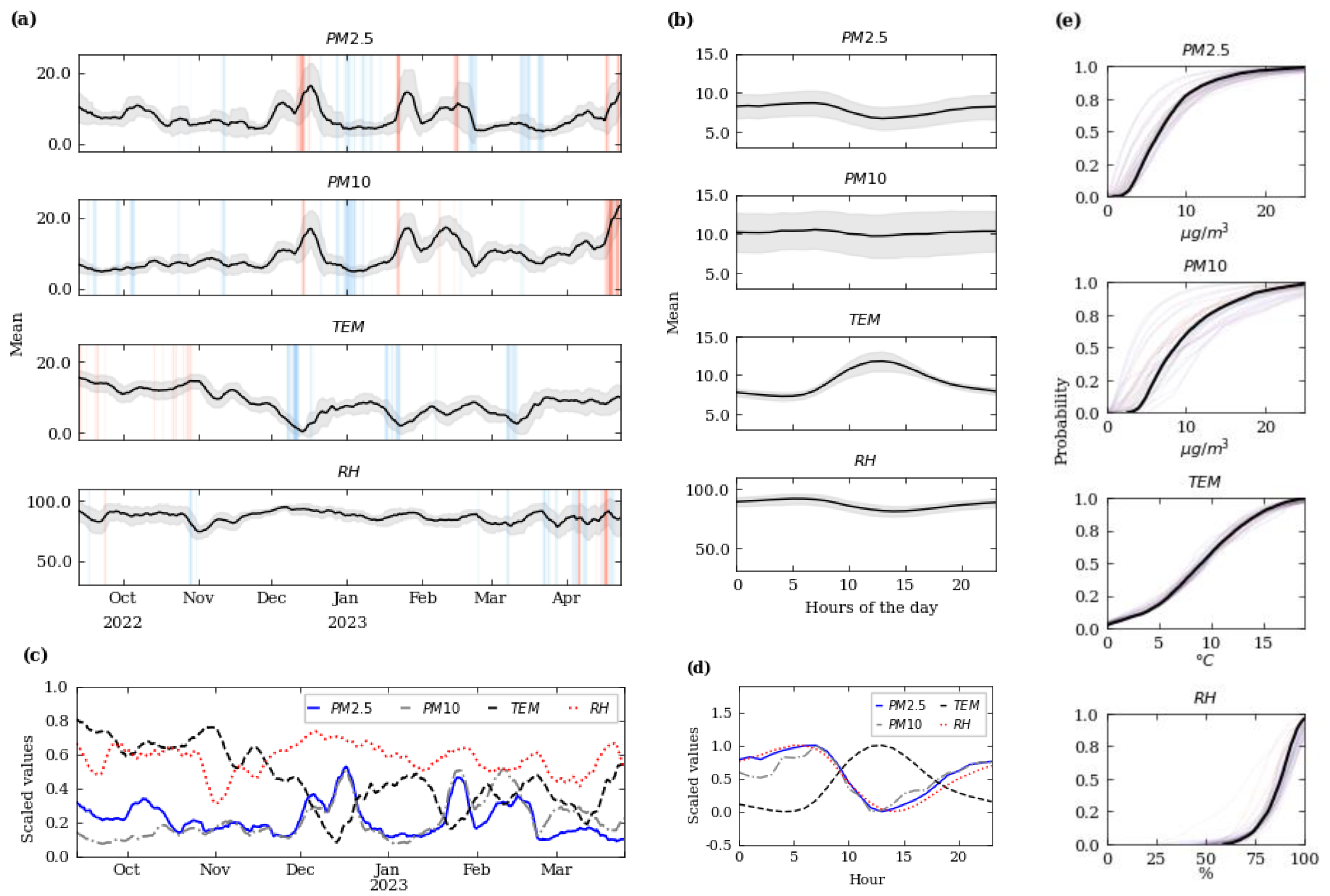
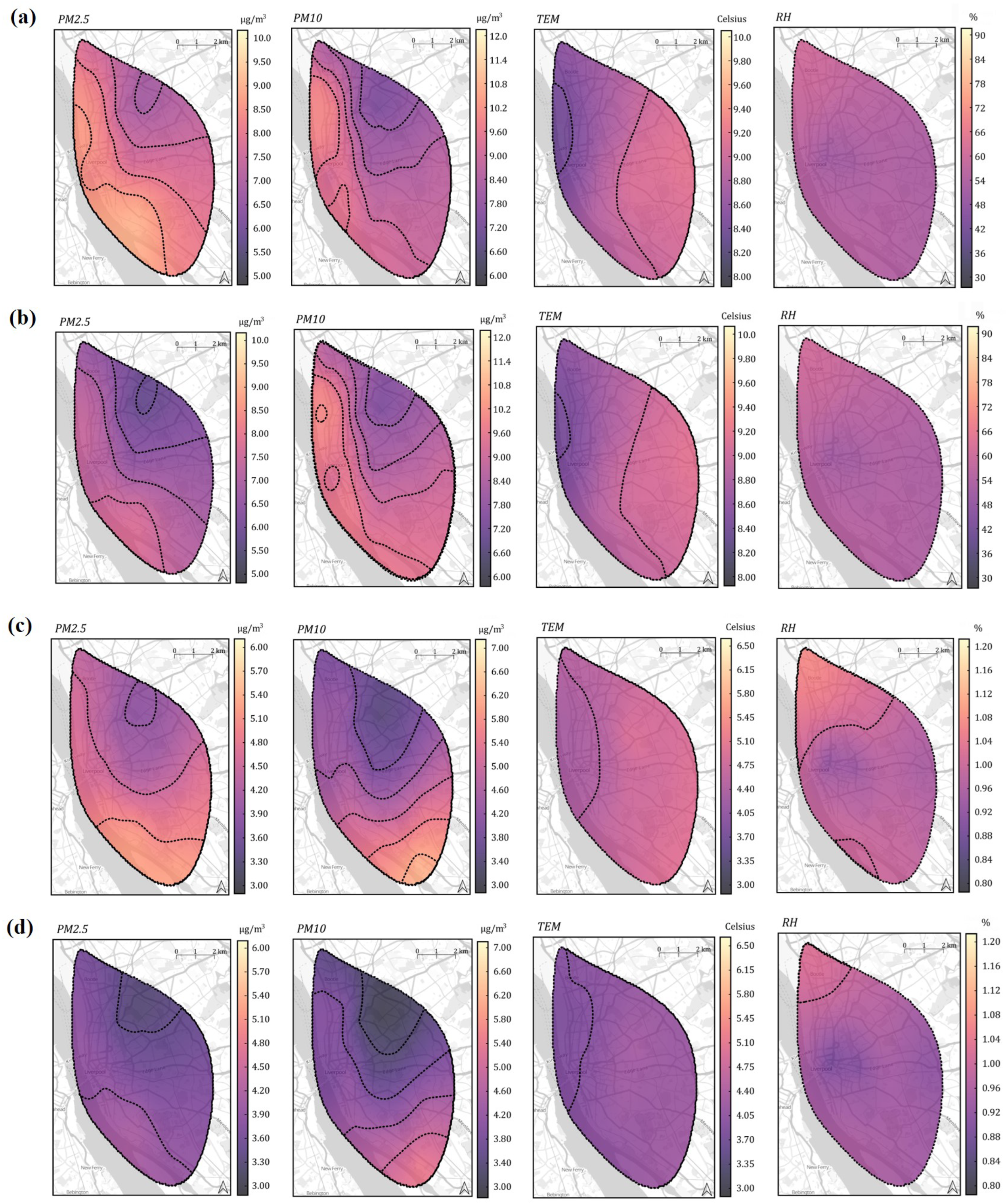
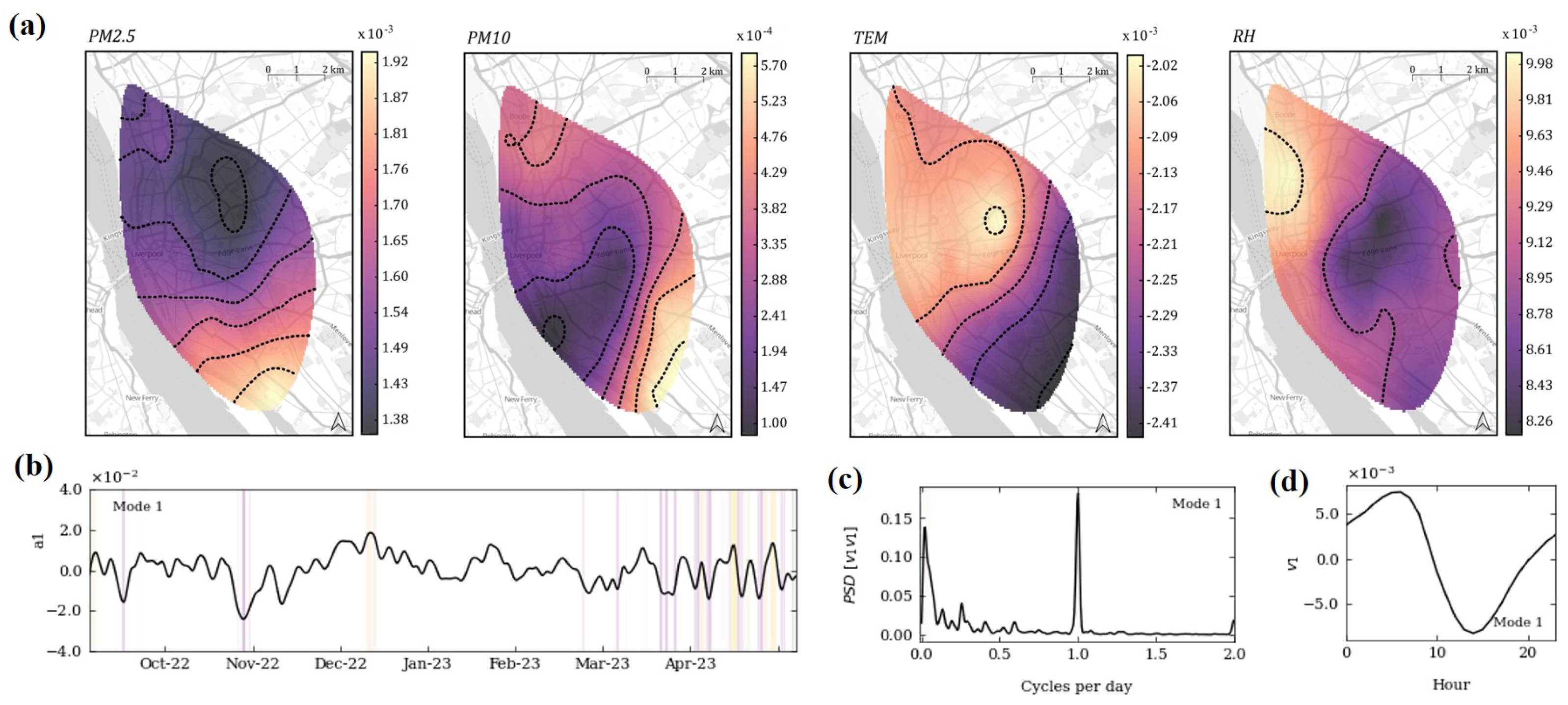
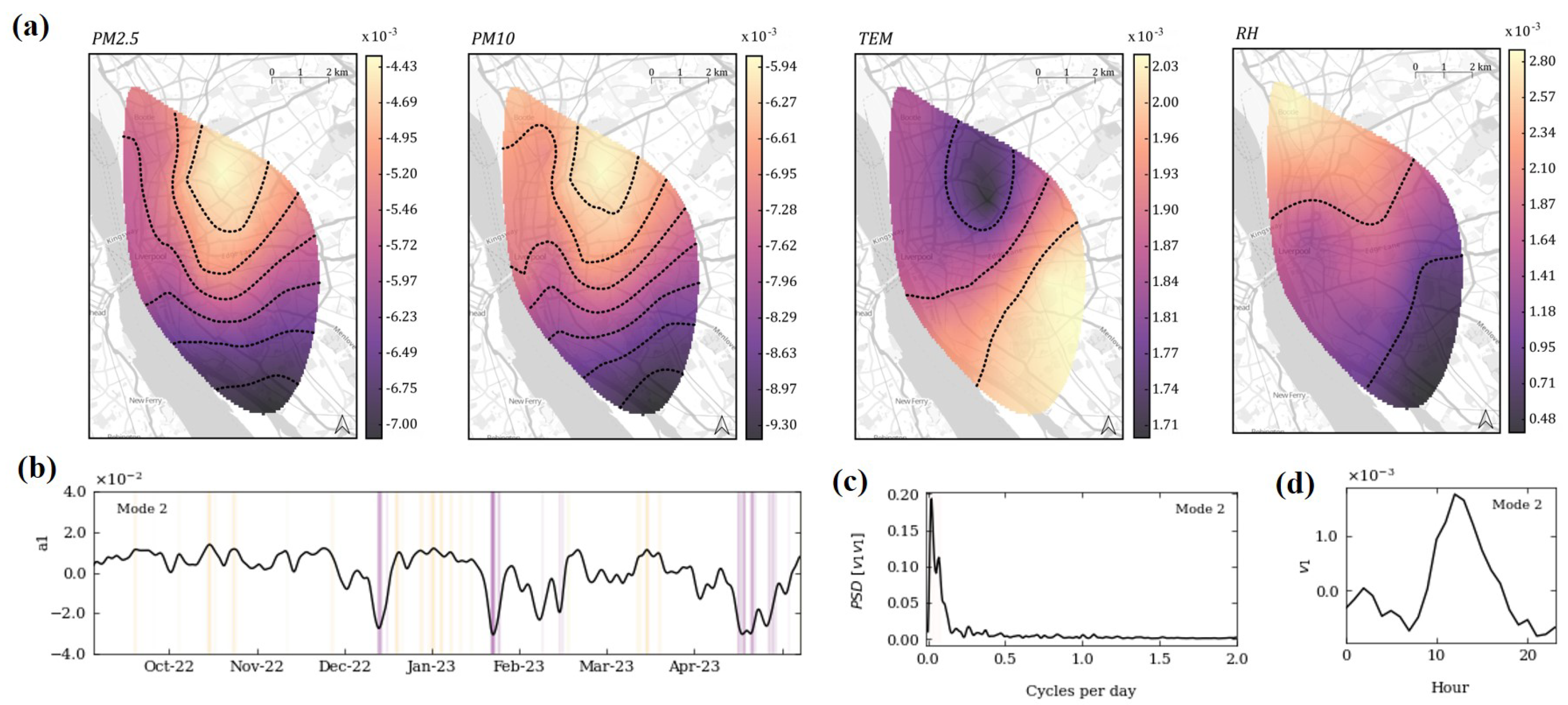


Disclaimer/Publisher’s Note: The statements, opinions and data contained in all publications are solely those of the individual author(s) and contributor(s) and not of MDPI and/or the editor(s). MDPI and/or the editor(s) disclaim responsibility for any injury to people or property resulting from any ideas, methods, instructions or products referred to in the content. |
© 2025 by the authors. Licensee MDPI, Basel, Switzerland. This article is an open access article distributed under the terms and conditions of the Creative Commons Attribution (CC BY) license (https://creativecommons.org/licenses/by/4.0/).
Share and Cite
Acosta Ramírez, C.; Higham, J.E. Application of Proper Orthogonal Decomposition to Elucidate Spatial and Temporal Correlations in Air Pollution Across the City of Liverpool, UK. Urban Sci. 2025, 9, 166. https://doi.org/10.3390/urbansci9050166
Acosta Ramírez C, Higham JE. Application of Proper Orthogonal Decomposition to Elucidate Spatial and Temporal Correlations in Air Pollution Across the City of Liverpool, UK. Urban Science. 2025; 9(5):166. https://doi.org/10.3390/urbansci9050166
Chicago/Turabian StyleAcosta Ramírez, Cammy, and Jonathan E. Higham. 2025. "Application of Proper Orthogonal Decomposition to Elucidate Spatial and Temporal Correlations in Air Pollution Across the City of Liverpool, UK" Urban Science 9, no. 5: 166. https://doi.org/10.3390/urbansci9050166
APA StyleAcosta Ramírez, C., & Higham, J. E. (2025). Application of Proper Orthogonal Decomposition to Elucidate Spatial and Temporal Correlations in Air Pollution Across the City of Liverpool, UK. Urban Science, 9(5), 166. https://doi.org/10.3390/urbansci9050166





